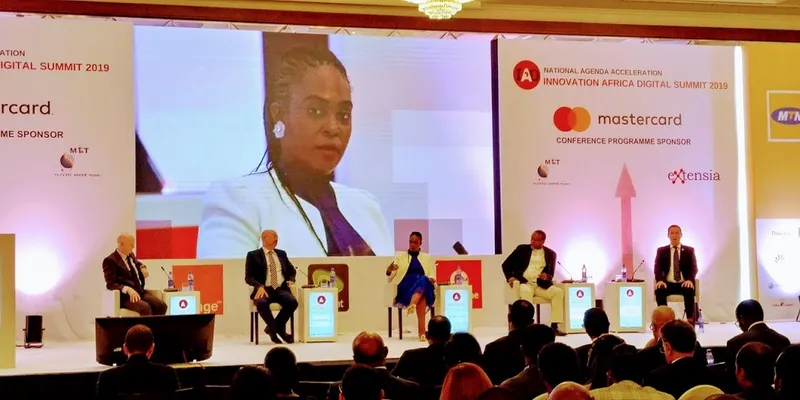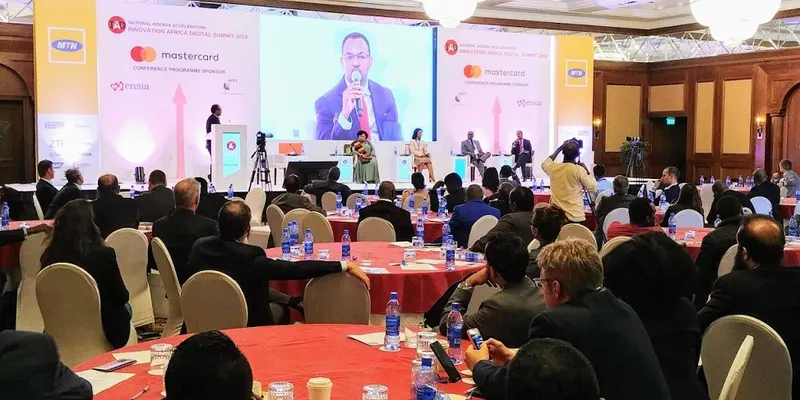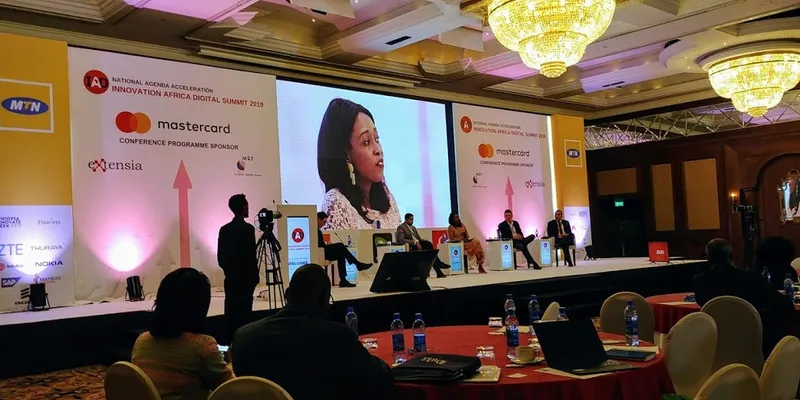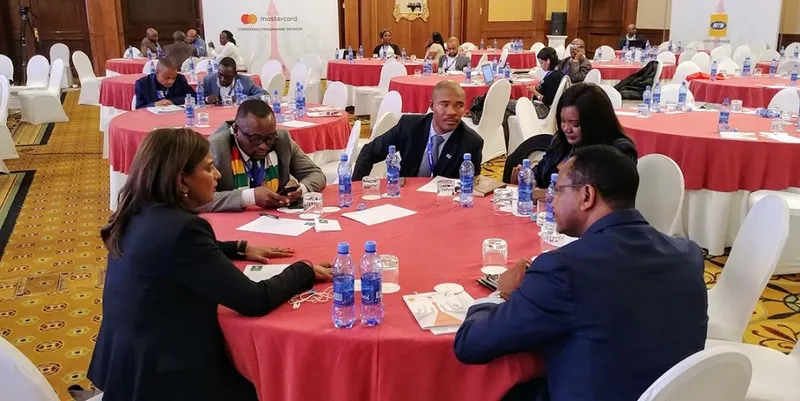Infrastructure, investment, innovation: how Africa is accelerating digital transformation
Speakers at Africa’s premier conference on digital technology and transformation identified infrastructure evolution, business models, and ecosystem innovation as key success factors to fully realise Africa’s digital future.
Over 450 industry experts representing 270 companies gathered in Addis Ababa last week for the Innovation Africa Digital Summit (IADS). Organised by Extensia, the 17th edition of the conference drew participation from 47 countries, of which 25 were from Africa.

As conference chair, here are my key takeaways on digital infrastructure, services, financial inclusion, regulation, and innovation ecosystems. See also my earlier conference coverage of IADS in 2018, 2017, 2016, 2015, and 2014, as well as the Youth Engagement Summit.
I. ICTs in Africa
“For over three decades, information and communication technology (ICT) maturity have become a major driver of competitiveness at the firm, industry, national, and international levels,” explained Oliver Chinganya, Director of the African Centre for Statistics.
In several African countries, the digital economy is becoming one of the main drivers of growth, accounting for more than 5 percent of the GDP. “Africa is seen as the world’s fastest growing telecommunications market,” added Chinganya. He cited the Ethiopia Commodity Exchange (EXC) as an example of an effective virtual marketplace accessible online, by phone and SMS.
However, 1 GB of data in Africa costs an average citizen 8.76 percent of average income, as against 1.54 percent in Asia, according to the Alliance for Affordable Internet. Chinganya urged African governments to make broadband affordable for all citizens. In that regard, UNECA has established a Centre of Excellence for Digital Identity, Trade, and Economy.
II. Digital infrastructure and services
Abdessattar Sassi, Chief Strategist, Middle East & Africa, ZTE showcased an “arithmetic framework” to explain transformation and optimisation of digital infrastructure like 5G. This includes subtraction (architecture simplification via common core, resource pooling, protocol simplification), addition (enhancing capability, bandwidth and experience; use of enterprise artificial intelligence), division (spectrum multiplexing), and multiplication (combining telecoms with other industries).
The 5G ecosystem is not just about a connected world but an intelligent world, explained Jonathan Adams, VP, Head of South and East Africa, Ericsson Middle East & Africa. Data traffic is expected to increase eight-fold from 2018 to 2023, with the number of connected devices increasing from 17.5 billion in 2017 to 31.4 billion by 2023. Ericsson predicts one billion 5G subscriptions in 2023.
Adams traced the cumulative benefits and “killer applications” of mobile waves like 2G (voice, SMS), 3G (internet browsing), and 4G (video). 5G will additionally open up the market for IoT in multiple industries.
Availability, affordability, and quality are key factors for 5G digital service adoption, according to Daniel Jaeger, Market Unit Head - Central, East and West Africa, Nokia Networks. Countries need to create knowledge hubs, improve collaboration, and attract investment to get ahead in the 5G race.
Mobile and fixed ICT adoption needs to be promoted across vital sectors of the economy. Jaeger classified markets into dense urban, urban, suburban, rural township, and remote rural, with different combinations of telco infrastructure. Infrastructure is only half the equation; alignment with the United Nations Sustainable Development Goals is key, he urged.

Networks and devices based on L-band communication offer a lot of potential for a vast continent like Africa, explained Roen Menezes, Regional Director – Africa & South Asia, Thuraya. The company covers more than two-third of the world’s population with its two geo-satellites. Applications include humanitarian intervention during disasters, offshore oil exploration, business operations, adventure travel, election monitoring, and fishery services.
Cost-cutting and innovation can be enabled via infrastructure sharing, explained Kash Pandya, CEO, Helios Towers. Sub-Saharan Africa has a population of 1.06 billion, with 469.7 million subscribers; 63 percent of the population is under 30-years-old.
The “data tsunami” calls for significant infrastructure investment by operators, estimated at $29 billion of capex by 2023, according to Pandya. “TowerCos are increasingly seen as the solution and own the majority of the world’s towers,” he said. Sub-Saharan Africa today has a third of the world’s towers, a total of 150,000.
Mobile is also opening up an entire ecosystem of talent in content and business services like marketing, observed Mophethe Moletsane, GM, Digital Commercial Management, MTN Group. “Local content has significant viewership,” he said, pointing to music and games as examples.
Moletsane called for more partnerships to nurture grass-roots talent and startup hubs, along with universities and government institutions. Local talent requires support to be able to develop and package creative work for pan-African and global markets.
See also my related articles on Africa4Tech 2016, book review of Success in Africa: CEO insights from a continent on the rise, and the app African Proverbs, available for Android and Apple devices (first released by Extensia as a pocketbook at IADS 2013 in Addis Ababa).
A wide range of digital services that can accelerate African development was presented by Alioune Ndiaye, CEO, MEA, Orange. These include 12 m-agri services in eight countries, solar energy kits for seven countries, e-learning in over 500 schools, and e-health services (such as SMS reminders for vaccination).
Orange supports entrepreneurship in Africa via 50 million euros in funding for startups, four incubators, and 122 digital centres to train women. Orange Money is used by 40 million subscribers, enabling services like loans for the needy.
Africa also needs to look beyond the current landscape and position itself for success in frontier technologies, urged Dr Solomon Assefa, Director, IBM Research – Africa. These are in domains ranging from materials and mathematics to behavioural science and biology. Emerging scenarios could include Blockchain-enabled supply chain monitoring, AI-based decision support for agriculture, microfluidics chips for chemical analysis, and tele-radiology.
"Data is transforming industries and creating new ones,” Assefa explained. He classified AI into three types: narrow (emerging), broad (disruptive and pervasive), and general (revolutionary, from 2050 onwards).
At the same time, Assefa cautioned against unwanted and unforeseen bias in algorithms, particularly with respect to racial identification and stereotyping. “Trust and transparency is integral to the success of AI,” he urged.
III. Financial services and inclusion
Jens Schulte-Bockum, Group COO, MTN Group, identified trends such as GDP growth and urbanisation in Africa that support the digital opportunity, and in turn drive digital adoption. Africa has fast-growing and youthful populations, with large potential for mobile financial services – particularly since only a fifth of the population has a bank account.
The number of MTN Mobile Money users is expected to increase from 27 million in 2018 to 125 million in 2025, bringing in novel forms of financial inclusion. Africa’s mobile broadband connections are expected to increase from 560 million in 2018 to 841 million in 2021, according to Schulte-Bockum.
World-class innovation in digital financial services is emerging in Africa, as shown by M-Pesa and the services layered on top of it, according to Ken Okwero, Executive Head of Strategy, Safaricom. In the area of mobile money, he classified African countries into three categories: mature markets (Kenya, Tanzanian, Uganda); maturing (Zambia, South Africa); and sleeping giants (Egypt, Nigeria, Morocco).
Examples of services taking advantage of M-Pesa include M-Kopa (solar energy) and M-Tiba (healthcare). In the agriculture sector, mobile financial services are helping more farmers get affordable loans, along with inputs on land preparation, planting seeds, crop care, and post-harvest services.
Digital technology and electronic payments systems are becoming democratised, explained Ngozi Megwa, Senior Vice President, Digital Partnerships, Middle East and Africa, Mastercard. She cited research data which predicted that in 2022, global card and digital payment penetration will be at 60 percent, up from 44 percent today. Trends like open banking will transform the financial services sector, she said.
“A widespread unified digital infrastructure plays a key role in powering inclusive growth for economies,” Megwa emphasised, also stressing on the importance of trust and security. The company is engaging with startups and banks to drive further innovation.

A panel moderated by Ben Cheick Haidara, CEO Orange Burkina Faso, highlighted that financial inclusion is one of the biggest challenges for African leaders. Many African countries have less than 20 percent financial inclusion rates, as compared to more than 80 percent for Western countries.
Telco-led models are popular in most African countries (eg. Kenya, Sénégal, Cote d'Ivoire, Cameroon) with more than 60 percent financial inclusion rate. With the bank-led model (Ethiopia, Egypt, Nigeria), penetration is lagging behind with less than 40 percent financial inclusion rate.
Inclusion includes a social component as well, and more progress needs to be done to ensure secure and affordable ICT access for women and the disabled, according to a panel moderated by Dr Dawit Bekele, Director, African Regional Bureau, Internet Society.
Research reports, findings, case studies, trends and recommendations were shared by GSMA and Alliance for Affordable Internet. It was pointed out in the discussion that Nairobi now has a hub for developing and promoting assistive technologies for senior citizens.
IV. National policies and regulation
A panel moderated by McKinsey Partner Lohini Moodley featured representatives from the private sector (Bofinet) as well as from the government (ICT ministers and deputy ministers from Ethiopia, Zimbabwe and Sierra Leone). “There is a strong correlation between ICT readiness and global competitiveness. ICT readiness includes the political and regulatory environment, business and innovation environment, infrastructure, and affordability,” Moodley explained.
Research reports indicate that a job in the ICT sector creates three other jobs in other sectors. A number of African countries have developed clear ICT plans and targets for internet penetration and mobile coverage. Infrastructure investment and consumer education need to be increased, according to Moodley, as well as infrastructure partnerships across telco, logistics, and utilities.
Dr Bashir Gwandu, Non-Executive Chairman, Commonwealth International Telecoms Union (ITU) Group (CIG), advised that countries need good laws and policies as well as strong and independent regulators. They need to encourage investment while also protecting the consumer.
Kamal Sameer Shehadi, Chief Legal & Regulatory Affairs Officer, Etisalat, explained that transitional risk mitigation and spectrum policy are important issues to be addressed by regulators. Independence of the regulatory authority calls for careful design, along with multi-disciplinary competency of the planners.
V. Spotlight: Ethiopia
IADS 2019 took place in Addis Ababa at an exciting time of growth and development in Ethiopia, with the backdrop of market liberalisation, digital transformation and the renewed vision for the development of a world class ICT Park in the country of 100 million people.
The change in leadership across government and Ethio Telecom and the creation of the Ministry of Innovation and Technology (MInT) has re-invigorated the sector. This presents valuable opportunities for international enterprises to enter the Ethiopian market.
Sisay Tola, State Minister Ministry of Innovation & Technology (MiNT), Ethiopia, shared a number of examples of the government’s support for ICTs across sectors. He also observed that the very definition of broadband is a moving target, and governments need to address digital needs and habits of a number of generations of users.
IADS 2019 was held during the inaugural edition of Ethiopia Innovate Week, which included an ICT Expo and Startup Pavilion. The rise of such annual events for the general public, and especially youth, bodes well for the digital movement in Ethiopia.

VI. The road ahead
Other interesting recommendations made by the speakers at IADS 2019 were the importance of transforming African countries into “talent magnets” to attract engineers, managers, and entrepreneurs from the African diaspora and from other countries. Attendees offered suggestions such as making Africa a hub for BPO and e-health services like tele-radiology.
The governments of Benin, Zimbabwe, and Rwanda announced that they have engaged with Extensia to host National ICT Agenda Acceleration programmes in their countries later this year, with more countries signing up as well. The digital changemaker community grows from strength to strength by connecting the people spearheading digital transformation, and not just connecting the dots of the technology infrastructure, according to Tariq Malik, CEO, Extensia.
In sum, national and continental momentum is accelerating to bring the fruits of the digital revolution to African citizens, communities, and organisations across the board.










